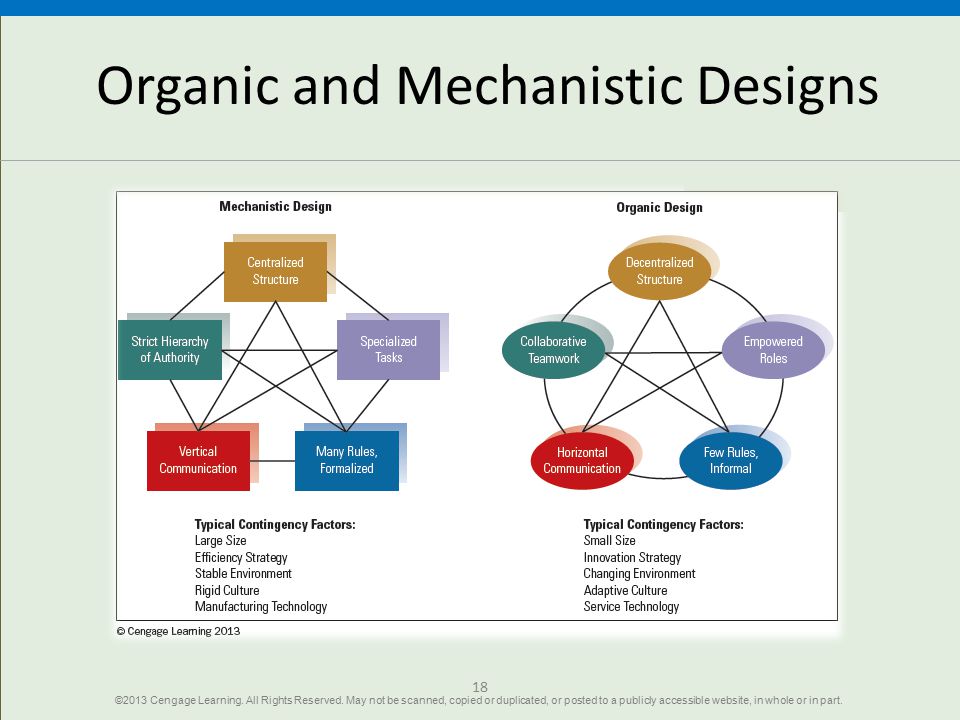Organic Versus Mechanistic Designs
Distinctions in Organic and Mechanistic Designs
OrganizationsOpens in new window can be categorized along a continuum ranging from a mechanistic design to an organic design.
Tom Burns and G. M. Stalker first used the terms organic and mechanistic to describe two extremes of organization design after observing industrial firms in England.
In general, a mechanistic design means that the organization is characterized by machine-like standard rules, procedures, and a clear hierarchy of authority.
Organizations are highly formalized and are also centralized, with most decisions made at the top. A mechanistic design is concerned primarily with efficiency.
An organic design means that the organization is much looser, free-flowing, and adaptive.
In organic design
- Rules and regulations often are not written down or, if written down, are loosely applied.
- People may have to find their own way through the system to figure out what to do.
- The hierarchy of authority is looser and not clear-cut.
- Decision-making authority is decentralized.
- The organic design is concerned primarily with learning and adaptation.
- Managers communicate a clear sense of direction and purpose and then empower employees at all levels.
- Knowledge and information are widely shared, and challenging the status quo is encouraged.
Various contingency factors will influence whether an organization is more effective with a primarily mechanistic or a primarily organic design.
 Figure X-5. Credit — Slideplayer Opens in new window
Figure X-5. Credit — Slideplayer Opens in new window
Figure X-5. Summarizes the differences in organic and mechanistic designs based on five elements: structure, tasks, formalization, communication, and hierarchy. The Figure also lists the typical contingency factors associated with each type of design.
- Centralized Versus Decentralized Structure
Centralization and decentralization pertain to the hierarchical level at which decisions are made. In a mechanistic design, the structure is centralized, whereas an organic design uses decentralized design making.
Centralization means that decision authority is located near the top of the organizational hierarchy.
Knowledge and control of activities are centralized at the top of the organization, and employees are expected to do as they are told.
With decentralization, decision-making authority is pushed down to lower organizational levels.
In a highly organic organization, knowledge and control of activities are located with employees rather than with supervisors or top executives. People are encouraged to take care of problems by working with one another and with customers, using their discretion to make decisions.
- Specialized Tasks Versus Empowered Roles
A task is a narrowly defined piece of work assigned to a person.
With a mechanistic design, tasks are broken down into specialized, separate parts, as in a machine, with each employee performing activities according to a specific job description.
A role, in contrast, is a part in a dynamic social system. A role has discretion and responsibility, allowing the person to use his or her judgment and ability to achieve an outcome or meet a goal.
In an organization with an organic design, employees play a role in the team or department and roles may be continually redefined or adjusted.
- Formal Versus Informal Systems
With a mechanistic design, there are numerous rules, regulations, and standard procedures. Formal systems are in place to manage information, guide communication, and detect deviations from established standards and goals.
With an organic design, on the other hand, there are few rules or formal control system. Communication and information sharing are informal.
- Vertical Versus Horizontal Communication
Mechanistic organizations emphasize vertical communication up and down the hierarchy. Top managers pass information downward to employees about goals and strategies, job instructions, procedures, and so forth, and in turn ask that employees provide information up the hierarchy concerning problems, performance reports, financial information, suggestions and ideas, and so forth.
In an organic organization, there is greater emphasis on horizontal communicationOpens in new window, with information flowing in all directions within and across departments and hierarchical levels. The widespread sharing of information enables all employees to have complete information about the company so they can act quickly.
In addition, organic organizations maintain open lines of communication with customers, suppliers, and even competitors to enhance learning capability.
- Hierarchy of Authority Versus Collaborative Teamwork
In organizations with a mechanistic design, there is a close adherence to vertical hierarchy and the formal chain of command.
Work activities are typically organized by common function from the bottom to the top of the organization and there is little collaboration across functional departments. The entire organization is controlled through the vertical hierarchy.
An organic design, on the other hand, emphasizes collaborative teamwork rather than hierarchy. Structure is created around horizontal workflows or processes rather than departmental functions, with people working across department and organizational boundaries to solve problems.
Organic design thus encourages intrapreneurship, so that people across the organization are coming up with and promoting new ideas that respond to needs of customers. Self-directed teams are fundamental work unit in highly organic organizations.
| Remember This |
|---|
|
Featured contents in the series:
- What Is an Organization?Opens in new window
- Multinational vs Non-Profit OrganizationsOpens in new window
- Organization DesignOpens in new window
- Structural Dimensions of Organization DesignOpens in new window
- Contingent Factors of Organization DesignOpens in new window
- Performance Efficiency and Effectiveness OutcomesOpens in new window
- Organic versus Mechanistic DesignOpens in new window
- Organizational Design AlternativesOpens in new window
- Organizational EffectivenessOpens in new window
- How to Measure Organizational EffectivenessOpens in new window
- Research data for this work have been adapted from the manual:
- Managerial Accounting: Tools for Business Decision Making By Jerry J. Weygandt, Paul D. Kimmel, Donald E. Kieso

